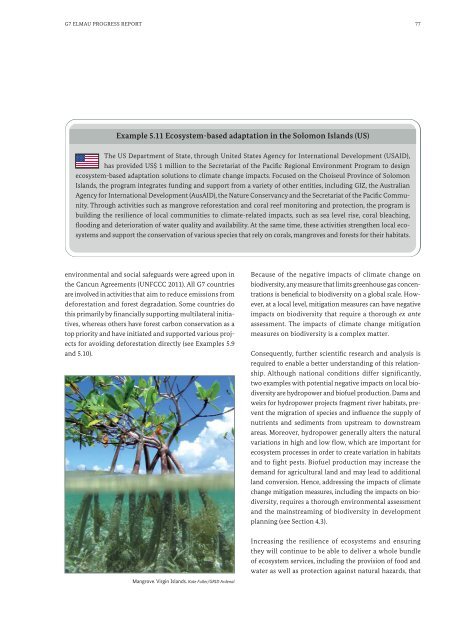G7-Elmau-Progress-Report-2015-Biodiversity-A-vital-foundation-for-sustainable-development
G7-Elmau-Progress-Report-2015-Biodiversity-A-vital-foundation-for-sustainable-development
G7-Elmau-Progress-Report-2015-Biodiversity-A-vital-foundation-for-sustainable-development
Create successful ePaper yourself
Turn your PDF publications into a flip-book with our unique Google optimized e-Paper software.
<strong>G7</strong> ELMAU PROGRESS REPORT 77Example 5.11 Ecosystem-based adaptation in the Solomon Islands (US)The US Department of State, through United States Agency <strong>for</strong> International Development (USAID),has provided US$ 1 million to the Secretariat of the Pacific Regional Environment Program to designecosystem-based adaptation solutions to climate change impacts. Focused on the Choiseul Province of SolomonIslands, the program integrates funding and support from a variety of other entities, including GIZ, the AustralianAgency <strong>for</strong> International Development (AusAID), the Nature Conservancy and the Secretariat of the Pacific Community.Through activities such as mangrove re<strong>for</strong>estation and coral reef monitoring and protection, the program isbuilding the resilience of local communities to climate-related impacts, such as sea level rise, coral bleaching,flooding and deterioration of water quality and availability. At the same time, these activities strengthen local ecosystemsand support the conservation of various species that rely on corals, mangroves and <strong>for</strong>ests <strong>for</strong> their habitats.environmental and social safeguards were agreed upon inthe Cancun Agreements (UNFCCC 2011). All <strong>G7</strong> countriesare involved in activities that aim to reduce emissions fromde<strong>for</strong>estation and <strong>for</strong>est degradation. Some countries dothis primarily by financially supporting multilateral initiatives,whereas others have <strong>for</strong>est carbon conservation as atop priority and have initiated and supported various projects<strong>for</strong> avoiding de<strong>for</strong>estation directly (see Examples 5.9and 5.10).Because of the negative impacts of climate change onbiodiversity, any measure that limits greenhouse gas concentrationsis beneficial to biodiversity on a global scale. However,at a local level, mitigation measures can have negativeimpacts on biodiversity that require a thorough ex anteassessment. The impacts of climate change mitigationmeasures on biodiversity is a complex matter.Consequently, further scientific research and analysis isrequired to enable a better understanding of this relationship.Although national conditions differ significantly,two examples with potential negative impacts on local biodiversityare hydropower and biofuel production. Dams andweirs <strong>for</strong> hydropower projects fragment river habitats, preventthe migration of species and influence the supply ofnutrients and sediments from upstream to downstreamareas. Moreover, hydropower generally alters the naturalvariations in high and low flow, which are important <strong>for</strong>ecosystem processes in order to create variation in habitatsand to fight pests. Biofuel production may increase thedemand <strong>for</strong> agricultural land and may lead to additionalland conversion. Hence, addressing the impacts of climatechange mitigation measures, including the impacts on biodiversity,requires a thorough environmental assessmentand the mainstreaming of biodiversity in <strong>development</strong>planning (see Section 4.3).Increasing the resilience of ecosystems and ensuringthey will continue to be able to deliver a whole bundleof ecosystem services, including the provision of food andwater as well as protection against natural hazards, thatMangrove. Virgin Islands. Kate Fuller/GRID Ardenal


